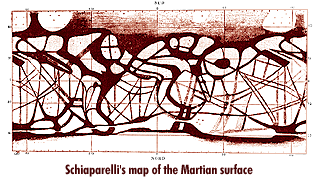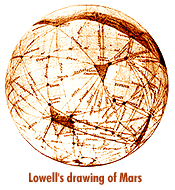Life on Mars?
 Percival
Lowell was intensely interested in Mars and the idea that canals built by
intelligent life there could be seen from Earth. He built the Lowell Observatory
in 1894 principally to study the red planet, and widely publicized his findings--gaining
admiration, enduring ridicule, and generally causing a furor.
Percival
Lowell was intensely interested in Mars and the idea that canals built by
intelligent life there could be seen from Earth. He built the Lowell Observatory
in 1894 principally to study the red planet, and widely publicized his findings--gaining
admiration, enduring ridicule, and generally causing a furor.
The first suggestion of waterways on Mars came from Italian astronomer Giovanni Schiaparelli, though he did not suggest they were artificial. In 1877 when Mars was at opposition--its closest point to Earth--Schiaparelli created a new chart of the planet. He noticed lines running across the surface and later wrote the following:
"All the vast extent of the continents is furrowed upon every side by a network of numerous lines or fine stripes . . . The canals may intersect among themselves at all possible angles, but by preference they converge toward the small spots to which we have given the name of lakes."He had used the Italian word canali, which means "channels." Rather unfortunately, this was translated as "canals," suggesting they were artificial in origin. And artificial structures suggested intelligent life had built them. There was much skepticism that the channels were there at all, since no one else could detect them. Yet Schiaparelli believed these channels carried away the flood water produced when the ice caps melted in the Martian Spring.

By 1886 several other reports verified the existence of the canals, complete with charts as fanciful as anything Schiaparelli had produced. Two people who invested energy in mapping the canals were William Pickering and Percival Lowell.
Lowell became fascinated with the idea of intelligent life on Mars, certain that the canals offered proof. He was wealthy enough to build his own observatory and carry on the investigation of Schiaparelli, who had given up studying Mars due to failing eyesight. That Lowell found supportive evidence of life on Mars is not surprising, since this is exactly what he set out to do. In a paper published before his work at the observatory began, Lowell wrote:
"Nevertheless, the most self-evident explanation from the markings themselves is probably the true one; namely, that in them we are looking upon the result of the work of some sort of intelligent beings." [P. Lowell, "The Lowell Observatory and Its Work," Boston Commonwealth, May 26, 1894.]
 Lowell proceeded
to draw his own elaborate maps of the planet, and published articles and
books about life on Mars. He had no doubt that the planet was habitable,
though not by beings resembling humans. While the popular notion held that
Lowell's Martians were earth-like creatures, Lowell himself never speculated
on the form they took.
Lowell proceeded
to draw his own elaborate maps of the planet, and published articles and
books about life on Mars. He had no doubt that the planet was habitable,
though not by beings resembling humans. While the popular notion held that
Lowell's Martians were earth-like creatures, Lowell himself never speculated
on the form they took.
Lowell studied the physical nature of the planet, finding further evidence for life, in a roundabout way. The polar caps contained ice, he noted, yet the rest of the planet was a desert. Rather than suggest the absence of life, to Lowell this explained the existence of the canals:
"If, therefore, the planet possesses inhabitants, there is but one course open to them in order to support life. Irrigation, and upon as vast a scale as possible, must be the all-engrossing Martian pursuit." [Percival Lowell, Mars, p.128]Lowell noted that the vast network of lines he observed were not the canals themselves, which were too narrow to be seen, but the wide path of cultivated land the canals irrigated. And the apparent geometric arrangement of the canals was all the more proof that minds of advanced intelligence had presided over their construction.
It was amazing how much Lowell divined about Martian society through the study of lines imagined on the planet's surface. He believed theirs to be an advanced civilization, far beyond politics and war, where "each individual has his place and fills it." A planetwide system of irrigation meant that all of Mars must be under one government, with "oneness of purpose."
Lowell lectured and wrote tirelessly on the subject, defending his theories and generating controversy. He endured ridicule in the press and was disappointed by the lack of acceptance for his theories by the scientific community. Still, the idea of life on Mars had gained wide popular support, inspiring such writers as H.G. Wells and Edgar Rice Burroughs.
In 1903, in the midst of the Mars furor, Lowell published The Solar System, in which he outlined his theory of planetary evolution. In this book, he clearly stated his belief that there was a ninth planet beyond Neptune, and that it would eventually be found. Percival Lowell, the greatest proponent of life on Mars and its controversial canals, was to become the benefactor of that discovery.

In 1965, Mariner 4 flew within 10,000 kilometers of Mars and sent back photographs of the surface. Mars showed no signs of canals, channels, or civilization, advanced or otherwise.